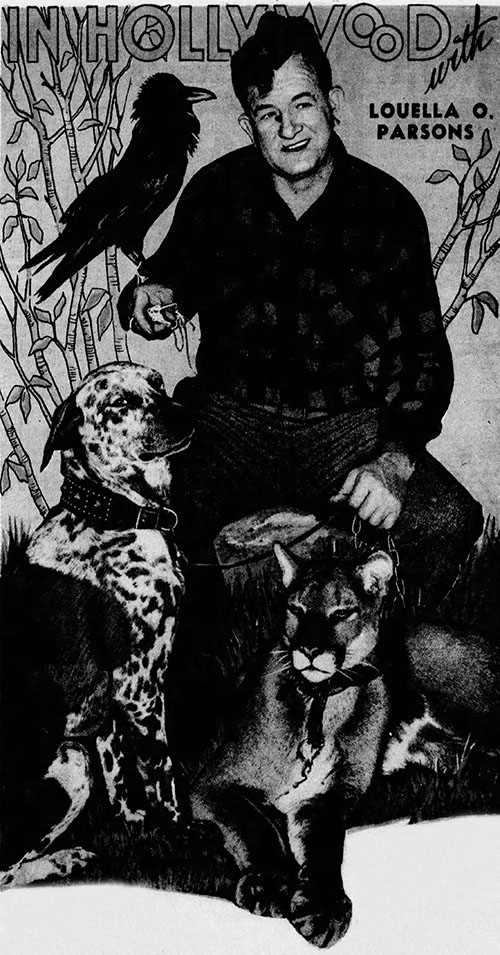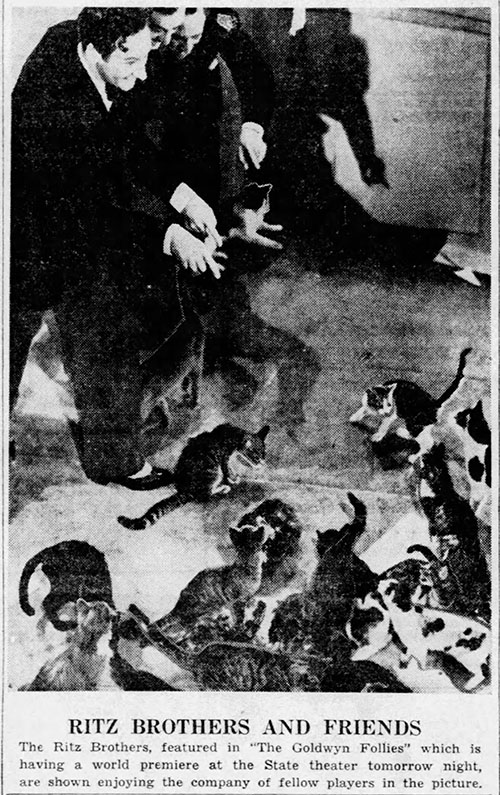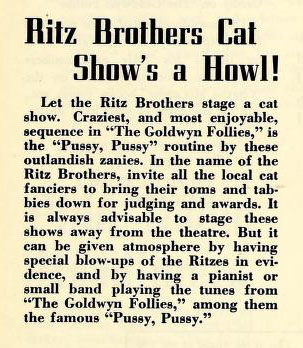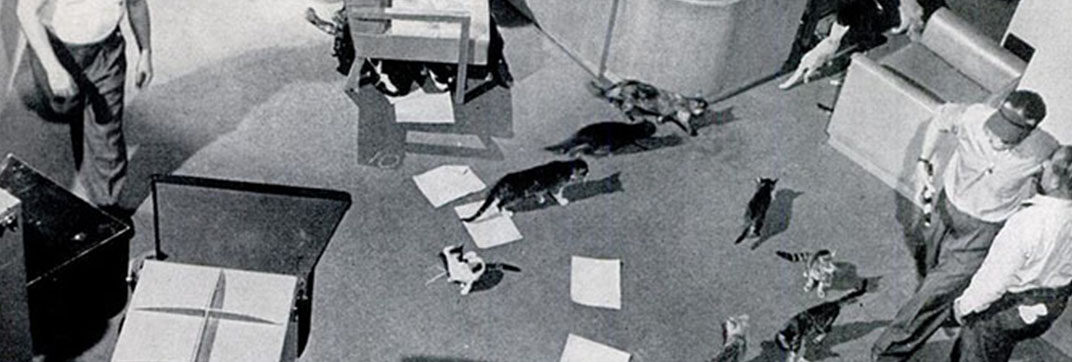Behind the Scenes of The Goldwyn Follies
When Samuel Goldwyn set out to make an all-star musical extravaganza it’s doubtful he expected it would lead to a furry invasion of his studio. But after The Ritz Brothers decided to spice up their number Here Pussy, Pussy with an extraordinary number of felines, things got a bit out of control . . . at least according to the Hollywood press at the time.
Several articles appeared throughout newspapers and magazines in late 1937 and early 1938 around the time of The Goldwyn Follies release which painted a picture of a massive clowder of cats descending upon an unwary studio and causing havoc around the shoot. Everything about these stories, from the number of cats involved to the chaos they caused and even an unexpected birth hints strongly at fanciful publicity exaggeration.
Let’s take a look at the scene in question:
The first article we could find was published in the Press and Sun Bulletin (New York) on September 28, 1937:
Movie Studio Has 300 Cats on Its Hands
3 Ritz Brothers Blamed, Who Thought It Would be a Good Gag
Hollywood, Sept. 28 — (United Press) — The Samuel Goldwyn studio had 300 cats — lady cats and gentlemen cats, big cats and little cats — on its hands today.
Goldwyn blamed the three Ritz brothers, who thought that it would be a good gag in their forthcoming picture if — when they went looking for a lost cat — they returned with a battallion of cats.
The cats were rounded up by Curly Twiford, Hollywood’s “animal man,” who supplies anything from bears to meadowlarks for the movie studios. He advertised in the papers, offering 75 cents per cat.
One youngster stole a cat from a police lieutenant’s house and sold it to Mr. Twiford. The lieutenant recovered his cat. The boy swiped it again, and Mr. Twiford, who by that time couldn’t tell one cat from another, paid for it again.
The 300 cats, ranging from well-groomed Angoras and Persians to dirt-caked alley prowlers, were delivered to Irving Sindler, the Goldwyn property man. Since the Ritz brothers won’t be ready to use the cats for a day or two, Sindler engaged an animal catering company to feed them at $120 a week!
Twiford doesn’t know what he will do when the cats are returned to him. He didn’t sell the cats but leased them to Goldwyn.
Throughout the articles the number of cats is always stated as being 300. While there are a very large number of cats in the film, we counted to the best of our ability there are never more than 100 cats on screen at one time, so we suspect that number was a bit inflated. Also the amount spent on the feeding of the cats while in the studio’s care, another point also emphasized across these stories, changes from $120 to $1200 (in the next story both numbers are used! The number stated the most often is $120.) It’s likely all of these articles had their origins from publicity materials provided by the studio. But the slight variations in each make them worth reviewing.
This next article was printed in The Pittsburgh Press on September 28, 1937 but variations of it were published in countless newspapers across the United States around the same time:
Cats of All Hues and Varieties Bring Yowling Bedlam to Goldwyn’s Studio
Goofy Idea of Ritz Brothers Proves Boomerang — It’ll Cost $1200 a Week to Feed the Kitties!
by Frederick C. Othman
HOLLYWOOD, Sept. 28 — A series of events, incredible anywhere but in Hollywood, reached a howling, yowling climax yesterday when truckload after truckload of cats rolled onto the Samuel Goldwyn lot.
The Three Ritz Brothers were in for something they hadn’t contemplated last week when they decided it would be a funny gag in the forthcoming “Goldwyn Follies” if — when they went looking for a lost cat — they returned with a lot of cats.
The studio immediately sent a requisition to the Hollywood animal man, Curly Twiford, for 300 cats, f.o.b. sound stage three.
Twiford hunted all over town for cats. He got 15 at the Old Soldiers’ Home, a dozen here, and a couple there. Still he had only a hundred or so. He advertised in the papers, offering to pay 75 cents cash for every cat delivered to him.
He delivered his feline merchandise. It included Angoras, Persians, Maltese, and alleys; pussies and toms; gentle cats, wild cats, and cats with long white whiskers. Never did we see so many cats. Neither did the Ritz Brothers.
They weren’t quite ready to lead the 300 cats into the offices of Adolphe Menjou, playing the part of a movie producer from whom they’re seeking jobs. So they turned their cats over to Irving Sindler, the property man. Sindler had handled a lot of things in his career, but never cats in wholesale quantities.
He called an animal catering company for an estimate on what it would cost to feed 300 cats for, say, a week.
“And they told me they couldn’t do it for a cent less than $120!” he moaned. “All I can say is that this cat business had better be an elegant laugh when it hits the screen.”
The glum-looking Curly agreed. His worried were even more serious.
“I’m not selling these cats to Goldwyn,” he said, “I’m just leading ’em. When the picture’s done, I get back my 300 cats. What’s bothering me is what am I going to do with ’em?”
‘Curly’ Twiford was indeed a well established name in Hollywood as an animal trainer. He got his start some years earlier when his garage business, located near the Hollywood studios, started to fail. Around that time he rescued a starving dog and her puppies and kept the runt of the litter, naming her Squeezit. Desperate for food, Twiford took Squeezit to a studio with him hoping for extra work. The dog was hired instead and a Twiford found his calling, training a wide variety of animals for film work.

In an interview with Hollywood columnist Louella Parsons published in 1946, she asked him specially about the training of cats. “Nobody can make a cat do what it doesn’t want to,” he answered. “You can baby ’em and teach ’em, but when a cat wants to walk, it walks, and when it wants to sleep, it sleeps. They’re the most independent of all animals.”
We should note that searches for the original ads reportedly placed by Twiford in the local papers turned up nothing.
Life Magazine jumped on the Goldwyn Follies story bandwagon, publishing this fascinating on set photo and story in their November 1, 1937 issue:
Movies – Hollywood Cats Refuse to Be Directed
Photograph for LIFE by Margaret Bourke-White

A roomful of cats was called for by Samuel Goldwyn to make a comedy scene in his Goldwyn Follies. Besieged with more than he wanted by small boys of Hollywood, Producer Goldwyn bought 300 at a cost of $1,000. The cats were supposed to rush into the office of a Broadway producer (Adolphe Menjou), swarm over him and his desk. Instead they refused to leave their anteroom. The director tried meat, fish, catnip, finally lured a few with butter. In the picture (above) the Ritz Brothers (in cutaways) are peering into the anteroom to see where the rest are.
While the cats were prowling about the floor, crawling under chairs, scratching fleas and peering through Venetian blinds, an agent of the S.P.C.A. arrived at the studio, representing irate owners of missing pets. The director shot his scene, dumped all 300 cats on the non-plussed agent.
The stories continued to appear well into 1938 as the film was shown in various theaters around the country. This piece was printed in The Miami News on January 27, 1938 with a twist about a pregnant cat that really is too hard to swallow. They even added a menacing villain to the tale in the form of a New York furrier!
Howling, Fighting Cats Gave Film Workers Heavy Problem
Ritz Brothers Inspiration For Gag Turns Into Feline Rout

(Special to Miami Daily News)
HOLLYWOOD, Jan. 27. — Sam Goldwyn got more cats than he paid for when one of his 300 howling, yowling, clawing, fighting felines gave birth to kittens under the blue white lights on stage three.
This produced three extra cats, but it cost Goldwyn $1,000 for a retake of the scene being filmed. (The script made no provision for maternity shots.)
It also cost Irving Sindler, the property man, a year of his life. He’s certain of that. Not only did he have to act as fight-stopper, scratch-bandager, yowl-shusher and especially cat-fancier-pacifier, but also he had to be midwife.
Other developments, like cats spread all over the lot. Irate cat owners, whose cats had vanished, besieged the movie citadels. The Humane society sent a platoon of cops to see that no cat got hurt. Ten men were clawed and Adolphe Menjou got fish oil on his best pair of gray tweed pants. A New York furrier wired a cash offer for cats, skinned.
The crisis in cats had its beginning when the three Ritz Brothers, Al, Harry and Jimmy, had an inspiration.
Playing in the film, “The Goldwyn Follies,” in which Menjou acts the part of a movie producer, the Ritzes were supposed to ask him for a job, singing. For no good reason, each was to carry a cat in his arms. This trio of cats was to escape, thus giving the brothers an opportunity to sing their song “Oh Pussy, Pussy, Pussy.” The original script called for the three cats to come back, but the Ritzes decided the laugh would be louder if a lot of cats strolled into Menjou’s office. So the studio placed an order with Curly Twiford, the animal man, for 300 cats, all for the sake of a laugh.
He produced ’em, after advertising that he’d pay 75 cents for every cat delivered to his animal shop. Cats disappeared all over town. Small boys had found a cat bonanza. The newspapers wrote editorials. Citizens’ associations adopted resolutions. Truckload after truckload of cats of all ages, colors and tempers, trundled through the Goldwyn gates.
While the directors and producers argued ways and means, Sindler cared for the cats. At last the fateful moment came. The color cameras were set up. Menjou was lolling behind his desk, looking bored and the Ritzes were singing “Oh, Pussy,” etc.
Harry opened the door offstage, leading to the 300 cats. The latter didn’t do a thing. “Scram,” said Sindler. A couple of cats walked in front of the camera. One of them, then and there, had kittens. Everybody felt a little embarrassed.
Sindler gave the mother and her litter a bed far away from the ensuing bedlam. Then he pondered methods of getting cats into the office, briskly. He sprayed fish oil on the trousers of the Ritzes. He rubbed their shoes with catnip and he tried again.
This time the cats hopped out a little quicker, but not quick enough. Once more the property man gathered up cats and put them back in their room, while the odor of fish became so strong Menjou insisted he could see it. Sindler sent for a tank of compressed air.
When the director said, “Shoot,” he turned the valve and the resultant hiss was better than that of a Tom cat. He got action. Two hundred and ninety-nine cats leaped into Menjou’s office. There were black cats, yellow cats, white cats, spotted cats and striped cats leaping across Menjou’s desk, under the desk, beneath the cameras, over the chairs and onto Assistant Director Eddie Bernoudy, hero of the occasion.
When the cats headed for Bernoudy, his only escape led past the purring cameras. He stood his ground and ground his teeth. Both his hands dripped blood, as if caught in a washing machine, but the film was saved.
Note: If anyone wants a free cat, address the Los Angeles Humane society. Samuel Goldwyn, Inc., Ltd., having decided not to do business with the New Yorker who wants to turn cats into coats, made a deal with the anti-cruelty folks to handle the catty aftermath.
The story of a cat giving birth right in the middle of a Hollywood shoot is really just too over the top to believe, especially when all the previous reports didn’t even mention a pregnant cat or kittens (Life Magazine wouldn’t have pounced on that story while on set??) The rest is plausible, as cardboard barriers were set up around the set (they can be seen in the Life photograph above) and the cats likely did have to be cajoled into leaving the anteroom (in some shots cats are obviously being nudged or even tossed through the doors.)
Finally a humorously doctored version of what happened graced the pages of the Berwyn Life (Illinois) on June 12, 1938:
Ritz Brothers Cry ‘Pussy!’ And 300 Cats Clutter Set
Cats to the right of them, cats to the left of them, cats under their feet and cats in their hair, the Ritz brothers were really having cat fits.
Al was giving catcalls, Harry was waving catnip, Jimmy said he’d take catsup.
Director George Marshall hoped it wouldn’t all turn out a catastrophe.
The scene was an office setting on a sound stage at the Samuel Goldwyn studio. The occasion was the filming of the “Pussy Pussy” number, a catalogue of caterwauls, cataphonics and hysterics featuring the Brothers Ritz and 300 cats for “The Goldwyn Follies,” the technicolor musical extravaganza which is currently featured at the Olympic theater.
Trained in back fence serenades and back alley harmony, the cats were in rare voice for their cinema debut. Their cutaway coats and striped morning trousers steeped in fish oil and reeking of liver, the Brethren Ritz were in ever rarer odor for the occasion.
Cardboard walls three feet high had been erected about the setting to keep the cats from running away and the Ritz boys within some reasonable bounds. The cats had been herded into an adjoining room. Cameras were focused, lights were set. Adolphe Menjou, innocent on-looker and possible victim of what threatened to be a cataclysmic event, took his seat behind a flat-topped desk. The Brothers Ritz took stances before him.
“Roll ’em,” commanded Marshall.
“Quit it,” snarled Al to Harry Ritz. “He means the cameras, you dope, not your eyes.”
“Pussy, Pussy, Pussy!”
“Camera,” shouted Marshall. “Start your song!”
“Oh Pussy, Pussy, Pussy, Pussy,” chanted the Ritzes. “Please come home.”
A door opened and the cats “came home.” They came in droves, in avalanches, in cataracts. There were black cats, white cats, yellow cats, striped cats, spotted cats, tame cats and wild cats. They leaped and frisked, bounded and jumped. They meowed and howled, yowled and growled.
Three of them made a catwalk of the luckless assistant director, Eddie Bernoudy, as he crouched out of camera range but not out of harm’s way.
“Cut,” called Marshall.
“They did,” said Bernoudy as he nursed a lacerated wrist.
This last article was pretty much copied straight out of the publicity section of the press book for the film. The book also offered promotional ideas for theater owners, such as the following suggestion for a cat contest (to be held away from the theater was their recommendation). We could find no evidence that any theaters took the studio up on this suggestion.

The Goldwyn Follies did not do well at the box office but this particular number forever cemented The Ritz Brothers, if not in the hearts at least in the minds, of cat-loving movie fans for all time.

